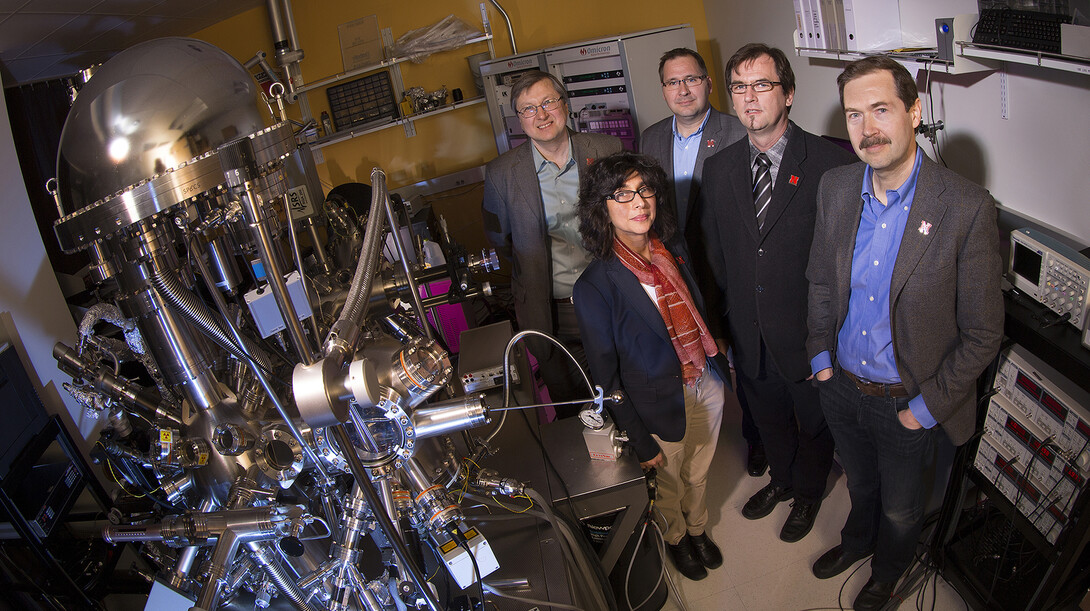
The University of Nebraska-Lincoln has earned a $9.6 million grant from the National Science Foundation to support its Materials Research Science and Engineering Center and its nanotechnology research through 2020.
Through this multidisciplinary center, UNL physicists, chemists and engineers collaborate to study nanostructures and materials that could lead to more energy efficient electronic devices.
UNL’s is one of 21 NSF-funded MRSECs nationwide. UNL established its MRSEC in 2002 with a $5.4 million NSF grant. In 2008, NSF awarded UNL $8.1 million to continue the center. UNL was one of 12 universities nationwide that received grants in the latest round of competition.
“With this award from NSF, we continue to be part of a prestigious group of institutions recognized for our expertise in materials research and education through the MRSEC program, which includes Columbia, Harvard, MIT, the University of Chicago, Penn State and Ohio State,” Chancellor Harvey Perlman said. “The achievements of our materials researchers are highly valued by U.S. and international scientific communities and greatly contribute to UNL’s reputation.”
The center receives a new name with this latest funding — Polarization and Spin Phenomena in Nanoferroic Structures, or P-SPINS — to reflect its expanding research focus on nanoferroic materials, which may one day transform electronics and computing technologies.
“Our MRSEC scientists are doing research at the frontiers of materials and nanoscience and although this is very basic research, it leads to advanced technologies and products that affect our everyday lives,” Prem Paul, vice chancellor for research and economic development, said. “An important part of the center’s work is developing collaborations with industry and national laboratories to focus on potential applications.”
The center’s success is based on several major accomplishments in understanding the properties and performance of nanomaterials, key steps toward improving computing power and creating advanced technologies, said Evgeny Tsymbal, George Holmes University Professor of Physics and MRSEC director. These discoveries have led the center to focus on two key areas: magnetoelectric materials and functional interfaces, and polarization-enabled electronic phenomena.
UNL physicist Christian Binek leads the magnetoelectric materials and functional interfaces research group. It’s based on Binek’s work with spintronics, which manipulates electron spin, in addition to charge, to generate power and store digital information.
Traditional magnetic memory devices use an electric current to reverse the magnetic direction, which is the binary method of storing information. Binek’s team discovered how to switch magnetization using voltage instead, which doesn’t generate heat and thus opens the avenue to energy-efficient computing.
This team now is developing voltage-powered logical and memory devices.
UNL physicist Alexei Gruverman leads the polarization-enabled electronic phenomena research group. This research takes advantage of nano-thin ferroelectric oxide, a material with both positive and negative polarization directions that, like spintronics, can be read out as a binary code using less energy than current technology.
The work is driven by Tsymbal’s theoretical predication and Gruverman’s experimental demonstration of quantum tunneling across nano-thin ferroelectrics. The phenomenon of quantum tunneling, in which particles, such as electrons, can pass through a barrier, occurs only at the quantum, or atomic, level. When voltage is applied, electrons are able to tunnel through the barrier, creating a current with resistance.
By experimenting with tunnel junctions, in which an ultra-thin barrier made of ferroelectric oxide is placed between two electrodes, they have shown that reversing the polarization changes dramatically the resistance through the tunnel junction. Measuring that resistance would allow devices to read the binary polarization direction, and thus, the information it contains.
Each of these nanomaterials hold promise for overcoming the limitations of traditional silicon-based electronics, which engineers say are fast approaching their functional limits. Harnessing nanomaterials would enable smaller, more powerful and less expensive computers and other electronics. Other applications include more energy efficient solar panels and refrigeration.
“Our niche, which I think is very exciting in terms of fundamental science, is very important from the point of view of applications,” Tsymbal said. “It’s a focused research area where we’re leading the field.”
The center’s work is highly collaborative with researchers from diverse disciplines sharing expertise. UNL’s MRSEC includes 18 UNL faculty from the departments of physics and astronomy, chemistry, electrical engineering, mechanical and materials engineering, and teaching, learning and teacher education. Two other MRSEC affiliates are at North Carolina A&T State University and the University of Wisconsin-Madison.
UNL MRSEC faculty collaborate with industry, national laboratories and scientists internationally and will interact closely with UNL’s Center for Nanoferroic Devices, established in 2013 and funded jointly by a consortium of industrial companies known as the Nanoelectronics Research Initiative and the National Institute for Standards and Technology, to develop device applications.
The latest NSF funding also will support expansion of the center’s traditionally strong education and outreach programs. UNL physicist Axel Enders will lead several ongoing and new initiatives, including those designed to encourage women and minorities into materials science research. Activities include conferences and mentorship programs with minority-serving institutions, such as the University of Puerto Rico and North Carolina A&T State University.
During summer research programs, undergraduates and faculty from non-research-intensive four-year institutions, as well as high school and middle school teachers, will continue to tackle research projects alongside the center’s faculty and staff.
Contact
Evgeny Tsymbal, George Holmes University Professor of Physics; director, UNL Materials Research Science and Engineering Center, 402-472-2586, tsymbal@unl.edu







